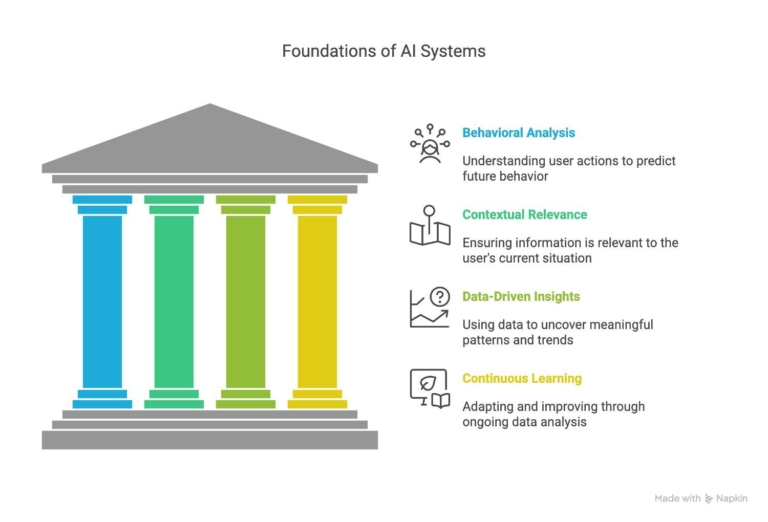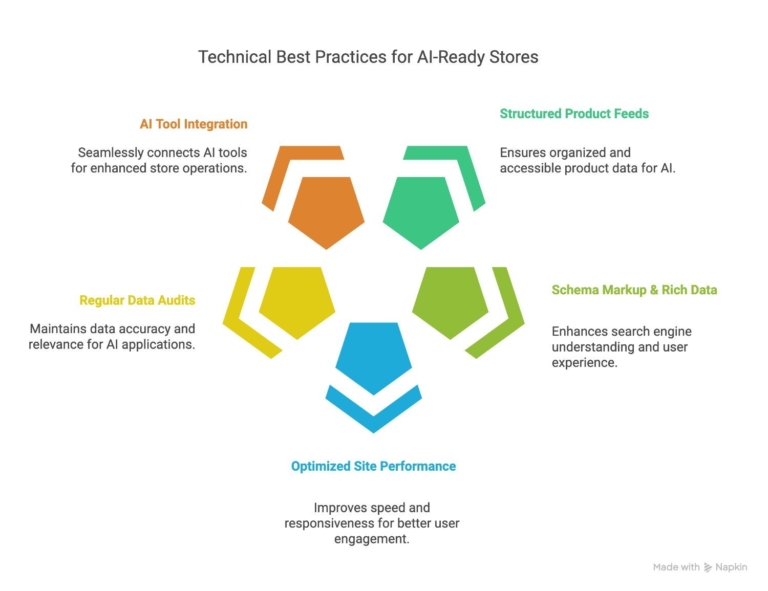Greetings! I'm Aneesh Sreedharan, CEO of 2Hats Logic Solutions. At 2Hats Logic Solutions, we are dedicated to providing technical expertise and resolving your concerns in the world of technology. Our blog page serves as a resource where we share insights and experiences, offering valuable perspectives on your queries.

Simply listing your products online is no longer enough. Shoppers expect personalized experiences that help them quickly find what they want. It can be whether they’re browsing online or exploring products in-store. This is where AI-powered search and recommendation engines come into play.
Optimizing your store for AI search and recommendations can dramatically improve product discoverability, increase customer engagement, and boost conversion rates. Create a smarter shopping experience that guides customers to the right products at the right time.
In this guide, you’ll understand how to optimize your store for AI search and recommendations. Let’s do it in a way that’s actionable, practical, and aligned with both customer expectations and business goals.
What is AI-Powered Search and Recommendations
To optimize your store for AI search and recommendations, it’s essential to understand how these technologies work and why they differ from traditional search systems.
Unlike basic keyword-based search, AI-powered search analyzes customer intent, behavior, and contextual signals. It considers factors such as past purchases, browsing history, and even product popularity to deliver highly relevant results. Similarly, AI recommendation engines predict what products a customer might want next, creating personalized suggestions that drive engagement and sales.
Key elements of AI search and recommendation systems include:

Behavioral analysis: AI tracks how customers interact with your store, identifying patterns in clicks, searches, and purchases.
Contextual relevance: The system understands context, such as seasonal trends, location, or product availability, to provide the most suitable results.
Data-driven insights: High-quality product data is crucial. Titles, descriptions, attributes, and images all feed into AI algorithms to improve accuracy.
Continuous learning: AI systems constantly adapt based on new data, improving recommendations over time.
Preparing Your Product Data for AI Optimization
A well-structured product catalog is the foundation when you want to optimize your store for AI search and recommendations. AI systems rely heavily on clean, accurate, and enriched data to deliver the right results to the right customer. If your product information is inconsistent or incomplete, even the best AI engine won’t perform effectively.
Key steps to prepare your product data:
- Enrich product titles and descriptions
Use clear, descriptive titles and detailed product descriptions. Avoid keyword stuffing, focus instead on accuracy and relevance so AI can better understand your products. - Standardize attributes and taxonomy
Make sure attributes like size, color, material, and category follow a consistent format. This helps AI algorithms match customer intent with the most relevant items. - Add metadata and structured tags
Include metadata such as brand, SKU, and product identifiers. Structured tags and schema markup improve discoverability both in AI-driven store search and external engines like Google Shopping. - Optimize images and media
Use high-quality images with alt text that clearly describes the product. Visual data is increasingly important for AI, especially as visual and voice search gain traction. - Ensure data accuracy and consistency
Regularly audit your catalog for duplicates, outdated information, or errors. Consistency is crucial for AI systems to interpret and recommend products effectively.
Optimizing for Omnichannel Experiences
Modern shoppers don’t just browse online. They move between digital and physical touchpoints. To truly optimize your store for AI search and recommendations, you need to create an omnichannel strategy where product data, personalization, and customer experience are consistent across every channel.
Key strategies for omnichannel AI optimization:
- Sync product data across systems
Ensure your ecommerce platform, ERP, PIM, and POS share the same product data. AI relies on clean, consistent information to deliver accurate search results and recommendations, whether online or in-store. - Enable AI-driven discovery in physical stores
In-store technologies such as smart shelves, kiosks, or mobile shopping apps can use the same recommendation logic as your website. This allows customers to receive personalized suggestions while shopping offline. - Create seamless online-to-offline journeys
If a customer browses products online, AI can recommend similar or complementary products when they visit your physical store. Likewise, data from in-store purchases can inform personalized online experiences. - Unify customer profiles across channels
AI works best when it has a complete view of the customer. Combine online browsing history, purchase behavior, and in-store interactions to deliver more relevant recommendations.
Using AI for Personalized Shopping Experiences
One of the biggest advantages of AI in eCommerce is its ability to deliver highly personalized shopping experiences. Customers today expect stores to “know” their preferences and present relevant products instantly. When you optimize your store for AI search and recommendations, you enable smarter personalization that feels natural and helpful.
Ways AI enhances personalization:
- Dynamic product recommendations
AI can display “frequently bought together,” “customers also viewed,” or “recommended for you” sections based on browsing and purchase behavior. These suggestions increase cross-sells and upsells. - Personalized search results
Instead of showing the same results to every shopper, AI tailors search rankings by factoring in past activity, demographics, and real-time behavior-helping each customer find the most relevant items quickly. - Context-aware promotions
AI can identify patterns, such as seasonality or location, and recommend promotions accordingly (e.g., suggesting winter jackets to shoppers in colder regions). - Customized homepage and navigation
Personalization extends beyond products. AI can adjust homepage banners, featured categories, or menus to match each customer’s interests.
Why it matters
Customers are more likely to engage with your store when they feel understood, and this translates into higher conversion rates and repeat purchases.
Optimizing your store for AI search and recommendations ensures that personalization isn’t an afterthought but a core part of the shopping journey.
Technical Best Practices for AI-Ready Stores
Optimizing your store for AI search and recommendations isn’t only about product data and personalization. It also requires technical readiness. AI systems perform best when your website and listings are structured, fast, and easy to interpret.

Key technical best practices:
- Structured product feeds
Ensure your product feeds to marketplaces, shopping engines, and internal search systems are complete, consistent, and regularly updated. Well-structured feeds help AI understand your inventory and make accurate recommendations. - Schema markup and rich product data
Implementing schema markup (Product, Review, Offer) allows AI to interpret product attributes, pricing, availability, and reviews more effectively, improving both search relevance and recommendation accuracy. - Optimized site performance
Fast-loading pages, mobile-friendly design, and efficient navigation improve AI search results and reduce bounce rates. AI algorithms often weigh engagement metrics, so speed and usability indirectly influence recommendations. - Regular data audits
Clean, accurate data is critical. Regularly check for missing attributes, outdated descriptions, or duplicate listings. AI relies on high-quality information to generate meaningful recommendations. - Integration with AI tools
Consider AI-powered search and recommendation platforms that integrate with your ecommerce system. This can simplify personalization, enable advanced analytics, and automate ongoing optimization.
Future Trends in AI-Powered Search and Recommendations
AI in ecommerce is evolving rapidly, and staying ahead of trends ensures your store remains competitive. By understanding future developments, you can continue to optimize your store for AI search and recommendations effectively.
Key future trends to watch:
- Generative AI in product discovery
AI will increasingly generate personalized product suggestions and even create dynamic content, helping customers discover items they might not have actively searched for. - Voice and visual search optimization
Shoppers are using voice assistants and visual search tools more frequently. Optimizing product data for these inputs ensures your store remains accessible across multiple AI-powered search modes. - Predictive personalization
AI will anticipate customer needs before they arise, offering recommendations based on predicted behavior, upcoming trends, or inventory changes. - Advanced omnichannel experiences
AI will continue to unify online and offline experiences, creating seamless, context-aware shopping journeys that adapt in real time. - Enhanced AI analytics
Future AI tools will provide deeper insights into customer preferences and behavior, allowing stores to fine-tune recommendations, promotions, and search results continuously.
Weekly Insights
Get our best content delivered to your inbox every week.
Conclusion
Optimizing your store for AI search and recommendations is no longer optional. It’s essential for creating personalized, engaging shopping experiences that drive conversions. Improve product discoverability and customer satisfaction but also future-proof your store against the rapidly evolving landscape of AI-powered retail.
For businesses looking for expert guidance, 2Hats Logic offers customized AI solutions tailored to your store’s unique needs, helping you maximize the benefits of AI search and recommendations.
Start optimizing your store for AI search and recommendations now to deliver a personalized shopping experience that keeps customers coming back.
Table of contents
- What is AI-Powered Search and Recommendations
- Preparing Your Product Data for AI Optimization
- Enhancing Product Listings for AI Recommendations
- Optimizing for Omnichannel Experiences
- Using AI for Personalized Shopping Experiences
- Technical Best Practices for AI-Ready Stores
- Future Trends in AI-Powered Search and Recommendations
- Conclusion

Related Articles








